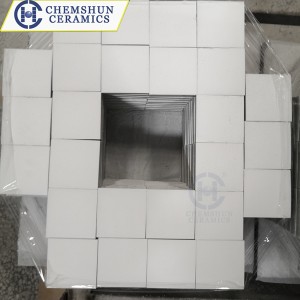As a high-performance protective material, alumina bulletproof ceramics have a wide range of applications. The following are its main application areas:
1. Military field: Alumina bulletproof ceramics are most widely used in the military field. It can be used to make bulletproof helmets, body armor, bulletproof plates, protective shields and other equipment to provide effective protection for soldiers. These equipment can effectively withstand the impact of bullets, shrapnel and other projectiles, thus protecting the lives of soldiers.
2. Police field: Police and special forces often use alumina bulletproof ceramics as body protective equipment when performing tasks. These equipment can not only effectively improve the safety and combat capabilities of police and special forces, but also make them more confident and determined when performing tasks.
3. Civilian field: In addition to military and police fields, alumina bulletproof ceramics are also widely used in civilian fields. For example, it can be used to make protective equipment for people in high-risk occupations, such as firefighters, workers, etc. In addition, alumina bulletproof ceramics can also be used in security facilities of important facilities, such as bulletproof glass and bulletproof wall panels in banks, museums, airports and other places.
In short, alumina bulletproof ceramics play an important role in military, police and civilian fields due to its high hardness, light weight and excellent protective properties.
The manufacturing process of alumina bulletproof ceramics mainly includes the following steps:
1. Powder preparation: First, the raw materials are prepared into high-purity alumina powder through specific chemical methods. During this process, the purity and stability of the raw materials need to be ensured to ensure the quality of the final product.
2. Forming: The alumina powder is processed into the required shape using a forming process. Common molding methods include pressing, injection molding, and molding. During the molding process, the particle size and distribution of the powder need to be controlled to ensure the accuracy and quality of molding.
3. Sintering: The alumina ceramic body is crystallized and dense through a high-temperature sintering process. At high temperatures, a dense grain structure forms between aluminum oxide particles, increasing the material’s hardness and durability. Usually, high-purity alumina ceramics require two sintering processes: pre-firing and final firing.
4. Processing: After sintering, alumina ceramics need to undergo cutting, polishing, hollowing and trimming processes to achieve good surface finish and dimensional accuracy. This step is also key to ensuring the quality of the final product.
The specific manufacturing processes and product requirements of alumina bulletproof ceramics vary. In the actual production process, adjustments and optimizations need to be made according to specific conditions. At the same time, in order to ensure product quality and production efficiency, it is recommended to strictly control the process parameters and quality standards of each link during the manufacturing process.
Post time: May-28-2024


